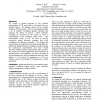Free Online Productivity Tools
i2Speak
i2Symbol
i2OCR
iTex2Img
iWeb2Print
iWeb2Shot
i2Type
iPdf2Split
iPdf2Merge
i2Bopomofo
i2Arabic
i2Style
i2Image
i2PDF
iLatex2Rtf
Sci2ools
UIST
2000
ACM
2000
ACM
Dynamic space management for user interfaces
We present a general approach to the dynamic representation of 2D space that is well suited for userinterface layout. We partition space into two distinct categories: full and empty. The user can explicitly specify a set of possibly overlapping upright rectangles that represent the objects of interest. These full-space rectangles are processed by the system to create a representation of the remaining empty space. This representation makes it easy for users to develop customized spatial allocation strategies that avoid overlapping the full-space rectangles. We describe the representation; provide efficient incremental algorithms for adding and deleting full-space rectangles, and for querying the empty-space representation; and show several allocation strategies that the representation makes possible. We present two testbed applications that incorporate an implementation of the algorithm; one shows the utility of our representation for window management tasks; the other applies it to th...
Allocation Strategies | Dynamic Representation | Full-space Rectangles | Software Engineering | UIST 2000 |
| Added | 01 Aug 2010 |
| Updated | 01 Aug 2010 |
| Type | Conference |
| Year | 2000 |
| Where | UIST |
| Authors | Blaine Bell, Steven Feiner |
Comments (0)

